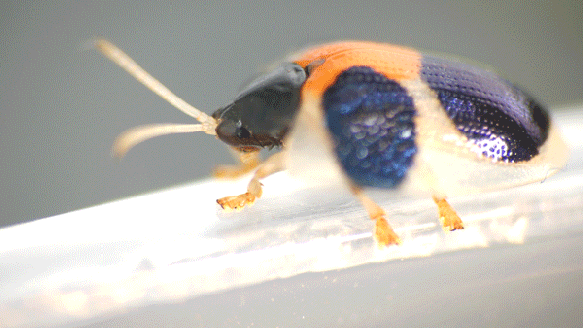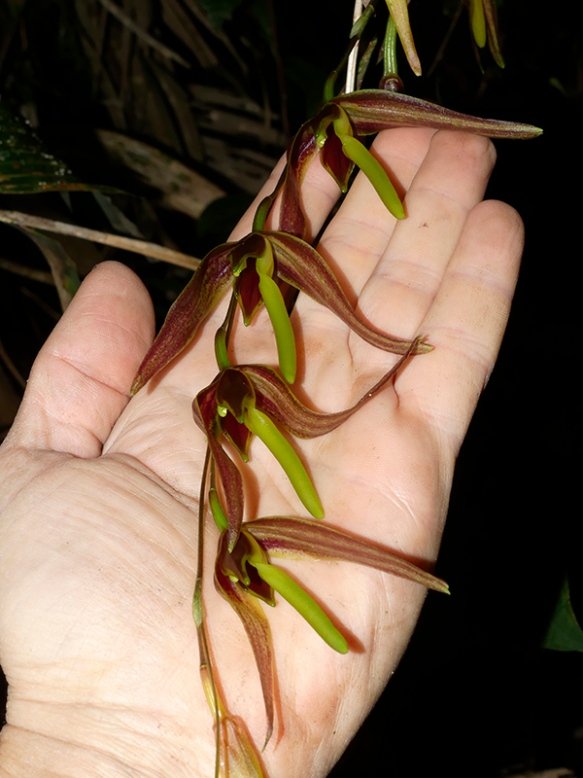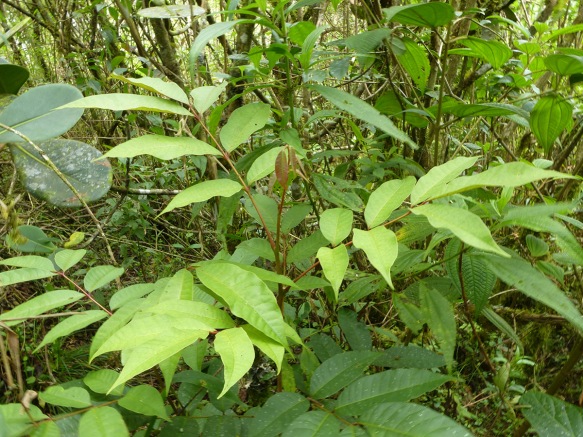
Chrysomelid beetle feet in action. Video: Lou Jost
A few weeks ago I visited the east ridge of our new Rio Machay Reserve, and found lots of interesting things. I also seemed to get through the visit without touching any Toxicondendron trees (same genus as poison ivy but more virulent), which had caused grave problems to my students and I a decade ago. Encouraged by this, I visited again last week, to search for new Magnolia species and interesting, biogeographically-informative orchids.
I picked a perfect almost-rainless day. The forest was beautiful in the sun, with lots of butterflies and other insects. Right at the start, at about 1600m, I found another beautiful chrysomelid beetle from the tribe Cassidini, a “tortoise beetle” similar to the fancy species I wrote about recently (“An insect that uses its own feces to build a statue of an insect or spider on its back”). This one had a more colorful pattern, which had no obvious function.

The beetle’s back pattern. Note the transparent sections of its shell. Photo: Lou Jost/EcoMinga.
The feet of these Cassidinae beetles are very unusual, with mop-like pads of long oily flattened hairs that stick tightly to even the smoothest surface. When the beetle feels threatened, it sticks tightly to its leaf with these fancy feet, and pulls its shell tight against the leaf surface. The shell extends beyond the feet so there is no place to get a grip on this slippery dome. It can hang on against a force 100 times greater than its body weight.
I’ve been wondering how the beetle detaches the sticky feet from the surface when it wants to walk. From looking at the feet of the previous species, I inferred that the two long claws between the pads could act as a lever to separate the pads from the leaf surface. However, I made that inference based on microscopic observations of the dead beetle’s claws. This new beetle gave me the chance to observe the feet in action.
A closer look at this chrysomelid beetle’s elaborate feet. Click to enlarge.
First I made some microphotos of the feet. The beetle sometimes stood still long enough to take the several hundred photos required to make each final image, though this required a lot of luck and patience. These feet had bigger secondary pads than those of the other species. Then I made a couple of videos of the feet in action. They are too big to include here, but I include a small reduced gif above, and I may put an additional one in a separate post, to keep this post from getting too heavy.
The full-sized video clearly shows that my earlier inference was wrong. The claws aren’t being used as a lever, at least not in the way that I imagined. The feet also pivot freely at times, as if the pads are not always sticky, though sliding might be easy since the surface tension isn’t broken (it is easy to slide a wet piece of glass over another piece of glass, but hard to pull them apart). Some articles had suggested that the beetle can produce the sticky liquid quickly when needed, and that the pads were normally not so sticky. Other people were skeptical of this, and the permanently-wet pads of the other species I photographed suggested that they were always sticky. I still don’t really know.

A miniature woodpecker, Lafresnaye’s Piculet, just 9 cm long, smaller than some cigarettes! Photo: Lou Jost/EcoMinga.
Also early in my climb I saw a pair of adorable Lafresnaye’s Piculets, tiny little woodpeckers that specialize in pecking the thin terminal twigs of branches where bigger woodpeckers can’t go.

This orchid, Sphyrastylis dalstromii, has unusual leaves and flowers. Photo: Lou Jost/EcoMinga.
An unusual orchid, Sphyrostylis dalstromii, first discovered by my friend Stig Dalstrom, hung down from a trunk on the side of the trail. These plants have iris-like dagger-shaped leaves and the stem grows continuously from its tip, unlike most New World orchids which make successive short growths from a rhizome.
Sphyrostylis dalstromii orchid flowers. Click to enlarge.Photo: Lou Jost/EcoMinga.
Later in my climb to the magnolia trees we’d recently discovered, I found one of the most spectacular Pleurothallis orchids in the world, P. (Elongatia) excelsa. I’d only seen this once before in my life. Most species in this artificial genus have tiny, dull flowers. John Jearrard writes this about the genus: “There is a strange fascination to Pleurothallis which are some of the dullest flowering plants imaginable. There are hundreds of them, actually more than 1000 at present but the number varies as more are found. The number reduces every time a botanist decides that a group aren’t really dull enough to belong, and shunts them off into a new genus. They are confusing, they are dull and they are fascinating.”
This species breaks all the rules of this group of orchids. It is huge, imposing, and spectacular. The plant is several feet tall and the pendant flower stalk is also several feet long. The flowers are enormous compared to the usual species. This plant was apparently not known from Ecuador until I found it here in the 1990’s. It was a real pleasure to see it again. (In a future post I might talk about its proper generic classification, which turns out to be very complicated. I think it is best placed in Elongatia, not Stelis, and certainly not Pleurothallis in any sense of that genus. See my article here for an introduction to problems of the old genus Pleurothallis, and see Wilson et al and Karremans for more technical discussion on the position of this species and its close relatives like “P.” restrepiodes.)

Click here to enlarge. The mysterious Magnolia tree I found here. I cleared out some of the bamboo which was beginning to overtake it. Some day we may see it flower so we can figure out what it is. Meanwhile we will include it in the laboratory Magnolia propagation project we are doing in collaboration with the Jardin Botanico de Quito and the Universidad Estatal Amazonica, financed by a grant from Botanical Gardens Conservation International. Photo: Lou Jost/EcoMinga.
Above that, at 2200m, I found a couple more of the giant-leaved mystery Magnolia trees I had come for. These have much bigger and more tapering leaves than the adult plants of our two new species of Magnolias from our nearby Rio Zunac Reserve. I strongly suspect they are different species, and hence probably new to science. [Note added April 30: Dr Antonio Vazquez, magnolia expert, and Eduardo Calderon, who has grown many Colombian magnolia species from seed, both say that juvenile magnolia trees often have much bigger leaves than adults, so I now think these forms are probably juveniles of the smaller-leaved species that Juan Pablo Reyes and our caretakers found on their visit here a few weeks ago. That may or may not be M. vargasiana, one of the new species from the Rio Zunac Reserve.] However w We do not know the juveniles of the new Magnolia species from the Rio Zunac, so we cannot rule out the possibility that one of those species has giant leaves when the tree is young. I could find no flowers, which would have settled the issue.
I thought this red seed I found on the forest floor might be a Magnolia seed, but expert Antonio Vasquez says it isn’t, because Magnolia seeds tend to be more angular, less rounded. Photo: Lou Jost/EcoMinga.
On my way down I was accosted by two Black-billed Mountain-Toucans (Andigena nigrirostris). These big toucans are always brave and curious in wild areas where nobody goes. These two came very close at eye level, rattling their beaks at me. But they were moving around too fast for good pictures. I got a few shots of one of them behind a tree. I include a better picture recently taken by Fausto Recalde in one of our other reserves. The Andigena toucans are among the most beautiful of the world’s toucans; besides this species, we are lucky to have two others in our reserves.
A Black-billed Mountain-Toucan scolds me. Photo: Lou Jost/EcoMinga.
It was a wonderful day, but the next day I felt sick. The day after, I felt worse, and saw why. My right arm and the right side of my face was covered with a red rash. By the third day my right eye was swelling shut. I knew immediately what was wrong…

This time the toxic tree Toxicodendron, whose local name is “alubillo”, got me again. This is the earliest stage. If left untreated my whole body would be covered with bursting yellow pustules in a week or two….Photo: Lou Jost/EcoMinga.
In my post from last week about this trail, I wrote “From 1996 to about 2004 I spent a lot of time exploring the western arm of the horseshoe, but only visited the eastern arm once or twice. A poisonous tree called Toxicodendron (same genus as American poison ivy) is common near the beginning of the trail up the eastern arm, and I developed a nasty allergy to it. A week after my last trip there (2004?), my eyes were swollen shut and yellow liquid dripped from my earlobes, and I nearly clawed my skin off from itching…. Since then I thought it best to avoid that ridge.”
I did not have problems after my trip two weeks ago. but this time, in spite of my care, I had apparently brushed against the dreaded Toxicodendron tree known here as Alubillo, which I had worried about in my earlier post. I knew that by next week, my whole body would be covered with this rash, and by the week after that, my eyes would be swollen shut and yellow liquid would be dripping from my ears. I don’t know what would happen after that— by the fourth week I had found a doctor who knew the cure (after many stupid doctors who prescribed nonsense). So I have now begun taking that cure, prednisone, and already I am better. (Added note: My friends who are reading this, please don’t worry about me, this is a common routine for me…)
[AApril 30: Photos of the Toxicodendron added below. Note to self: Learn to avoid!!]
Lou Jost
EcoMinga Foundation










